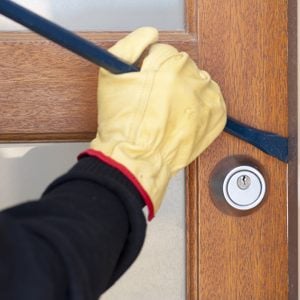Here’s Why You Shouldn’t Post Pictures of Your House Key Online
Updated: Nov. 13, 2022

Did you just move into a new home? Think twice before posting that classic photo of your keys.
Most people don’t think about safety until something goes horribly wrong. Of course, by that point, it’s too late and they’re kicking themselves for not taking the proper precautions. Sure, it’s a smart idea to invest in one of the best home security systems—there are even plenty without monthly fees, so you don’t have to spend a bundle. But there are also ways to protect your home that are completely free, and some of them including avoiding serious missteps on social media.
When you’ve just purchased a new home, you might be tempted to post that classic picture of your house keys, either on their own or with you proudly showing them off. Don’t do it! You’re about to be shocked by how burglars can use that one simple photo to break into your home. While you’re at it, find out which other photos you shouldn’t post online either.
It’s easy to copy keys from a photo you’ve posted online
Posting a photo with keys in front of a new home is a major social media trend, but Christopher Field of international security agency GOEX Worldwide warns this is a bad idea. “These photos often go on sites like Instagram, with a location tagged. Or even without the location tagged, it’s not clear that social media sites always remove the EXIF data that can reveal where photos were taken,” he explains. “Most photos these days are taken on smartphones, with very high-definition cameras able to pick up every notch on a key.” Once criminals have a photo of your key, there are several ways they can make a physical copy.
3D printers can make a copy of your key
The future is here…and that’s not necessarily a good thing for unsuspecting homeowners. “A photo of a key can be fed into most commercial computer-aided design programs to produce a digital outline,” Field explains. “Background items in the photo—such as other keys, hands, wedding rings, etc.—can be used for scale and size. Shadows can be used to estimate the depth of ridges.”
This digital outline can then be loaded into a key lathe or even a 3D printer to produce a working copy of your key. Criminals will likely create several versions with slightly different lengths and depths of ridges to ensure a match, Field adds.
Your exact key can be ordered online
Need an extra set of keys as a backup or to keep at your neighbor’s house? If your key has a code stamped on the head, says Field, an exact copy can be obtained from the manufacturer. While this is a major convenience for most people, it also means criminals can zoom in on the code they see in your social media posts and have a copy of your key sent right to their mailbox!
Services that make it easy for you to copy your keys also make it easy for criminals
The days of going to a locksmith or hardware store are over. Online services and apps make it simple for people to obtain a new set of keys—even if that person isn’t you. “When you use services like these, they take a digital photograph of your key, make a physical copy, and then mail it back to you,” notes technology expert Burton Kelso. “This, along with information that is obtained about your home from the social media post, could potentially allow a criminal to gain access to your home or vehicle.” While we’re on the subject, you should also consider the things that security experts never do in their own homes.
Other ways to keep your keys safe
Even if you don’t post that classic key photo on social media, you still might be putting your home and your safety at risk. Follow these expert guidelines so you’re not an easy target for burglars.
Don’t give your key to anyone
“The first method most people usually think of for nefariously duplicating a key hearkens back to spy films,” says Ahren Thielker, a physical security consultant at Pulsar Security. “The agent pulls out a small clay box and presses the key firmly in place, later pouring molten metal into the mold and theoretically creating a perfect duplicate.”
While this method might not sound all that plausible today, how about this? If someone has physical access to your key, they can firmly press it against their forearm and base their cuts to make the key on the depths observed in the marks left on their arm. “If the [thief] had a starting point of a photograph, they could also approach the lock with several keys they’ve filed into potential matches based on the photograph and approximate guesses for the depths,” says Thielker.
You might want to keep all of this in mind the next time you hand over your entire key chain to a parking valet. The bottom line: Always take your house key with you when you leave your car, either with an attendant or in a parking spot.
Keep your keys out of sight
Thielker recommends doing everything possible to safeguard your keys from public view. “If possible, keep your keys in a pocket or purse, and out of public view,” he says. “At home, it’s best to store your keys in a safe place, out of view from doors or windows.”
So, if you have a table or tray where everyone puts their keys by the door or a decorative key hook that can be seen through an adjacent window, it is wise to move it to another location in the house. Alternatively, you can keep your keys in a box that has a lid.
Spread the word
It’s not uncommon to give friends or neighbors an extra set of house keys, but before you do, realize they might not take the same precautions that you do. “If you have to make copies for friends or family, be sure to explain best practices for key safety because every additional key created is another potential exposure,” says Thielker. If you’re heading out of town, here are more things you should do before you leave for vacation.
Sources:
- Christopher Field, GOEX Worldwide
- Burton Kelso, chief technology expert at Integral



